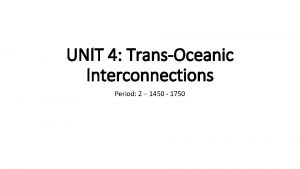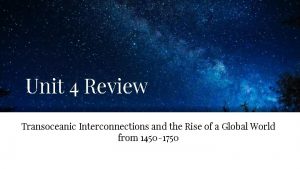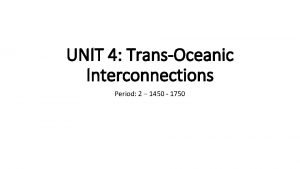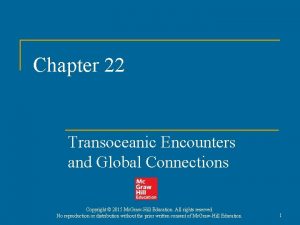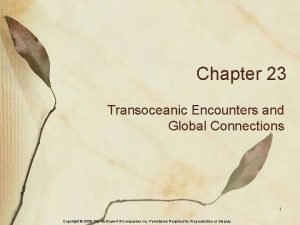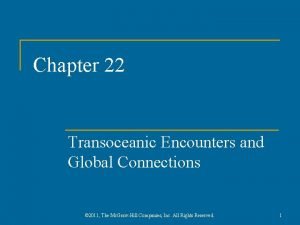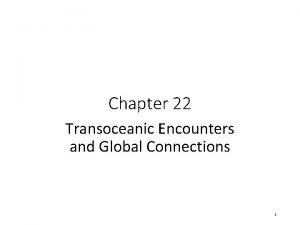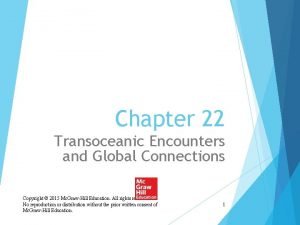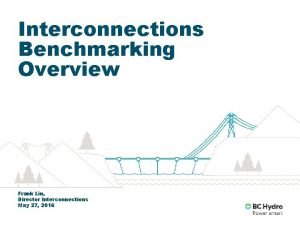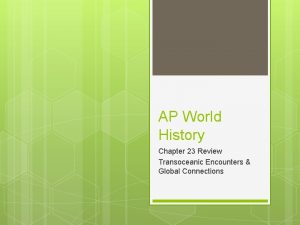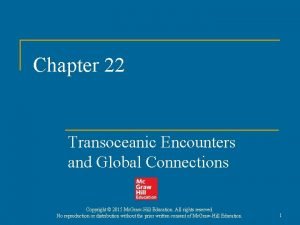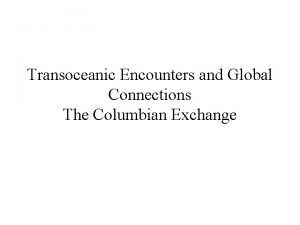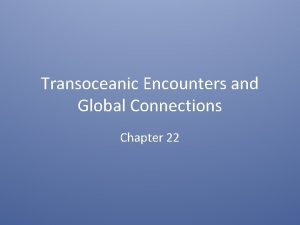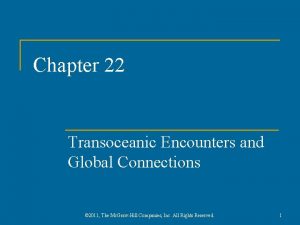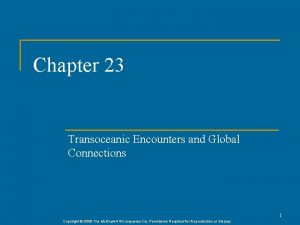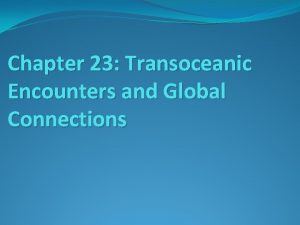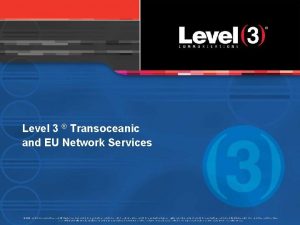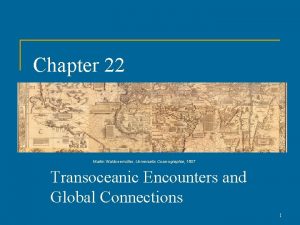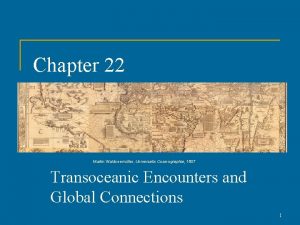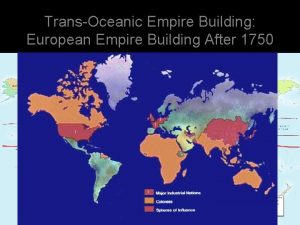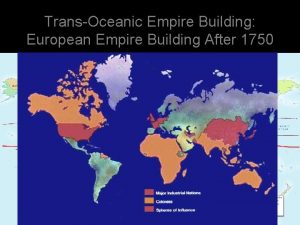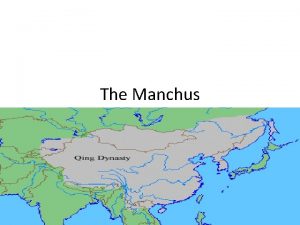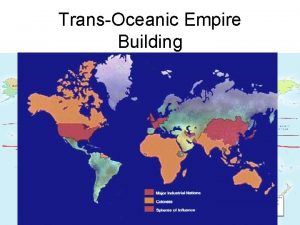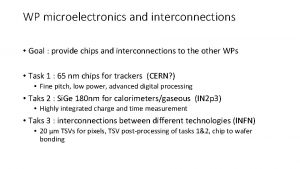Unit 4 Review Transoceanic Interconnections and the Rise

































- Slides: 33

Unit 4 Review Transoceanic Interconnections and the Rise of a Global World from 1450 -1750

4. 1 - Technological Innovations Essential Question: How did crosscultural interactions spread technology and facilitate changes in trade and travel from 1450 - 1750? 2

Maritime Trade had existed across land water for centuries, but as Europeans became more interested in the Indian Ocean trade networks, new patterns of trade began to develop. ❏ ❏ ❏ Europeans wanted to be involved in Indian Ocean trade but conflicts like the Omani-European rivalry encouraged European nations to finance expeditions like Christopher Columbus’ in search of water routes east. ❏ Omani European rivalry = Portuguese trading forts being challenged by locals. People like Prince Henry the Navigator encouraged maritime exploration and trade. ❏ He paid for expeditions along Africa’s Atlantic coast allowing Portugal to explore further than other European nations. The “discovery “of the new world by Columbus on behalf of Spain encouraged other European nations to fund water exploration and trade. ❏ This new pattern of long-distance trade and colonization led to the rise of the Maritime Empires - empires based on sea travel and trade rather than purely land expansion. 3

Innovations Various technologies were taken or improved from classical Islamic and Asian technology allowing Europeans to travel longer distances on the ocean than ever before. ❏ ❏ ❏ ❏ Magnetic Compass - taken from China helped point a ship in the right direction. Astrolabe - Taken from Muslim navigators this let sailors determine how far North or South they were from the equator. The Caravel - A small three masted ship developed by the Portuguese made sailing rough seas easier Cartography - Map Making Lateen Sail - Triangle sail that could catch the wind from any direction allowing ships to sail on the ocean. New Ships: ❏ Carrack - Portugal - square and lateen sails ❏ Caravel - Portugal and Spain - Lateen sails ❏ Fluyt - Dutch - Square Newton’s Ideas of Gravity - Increased knowledge of tides Astronomical Chart - A map of the stars and galaxies used for navigation 4

Long-Term Results ❏ The long-term result of combining navigational techniques invented in Europe with those from other areas of the world was a rapid expansion of exploration and global trade. ❏ The introduction of gunpowder aided Europe in these expansions. ❏ Interactions among various cultures inside and outside of Africa brought extensive trade and new technology to Africa. ❏ The success of European nations encouraged places like Russia to consolidated and grow its military. 5

4. 2 - Exploration: Causes and Events Essential Question: What were the causes and effects of the state-sponsored expansion of maritime exploration? 6

4. 2 - The Role of States in Maritime Exploration CONTEXT: At the beginning of the 1400 s, Italy controlled waterways between Europe and Asia, which meant they controlled the flow of goods between the two regions. This encouraged Spain, Portugal, France, and England to search for new water routes to Asia in search of riches, European dominance, and new places to spread Christianity (the three G’s - God, Glory, and Gold!). European nations were encouraged by Columbus’ “Discovery” of the New World. ➔ With the discovery of gold and silver in far away places, the economic policy of Mercantilism (sell more than you buy to increase your wealth) drove Europeans deeper into the global exploration game. ★ No nation supported exploration as heavily as Portugal. Three people led: ○ Prince Henry the Navigator - First European monarch to finance sea travel in search of a all-water route to the East. ○ Bartholomew Diaz - First to sail around the tip of Africa. ○ Vasco da Gama - Sailed further East than Diaz, all the way to India. ■ Portuguese ports in India was the first step towards the creation of their trading post empire. 7

4. 2 - Portugal and Trading Post Empires Portuguese Dominance: ➔ ➔ ➔ In the early 1500 s, Portugal has superior weapons and navigational technology. Afonso de Albuquerque won a battle against Arab traders to win the Port of Malacca (remember - this is like “buying the door” in the Indian ocean!) ◆ Allowed them to dominate the Indian and African costs. Went to China: ◆ Didn’t change China much, but missionaries followed. ◆ China didn’t like this and eventually close their doors to trade. Trading Post Empires: ➔ ➔ In order to ensure a monopoly in the Indian Ocean trade, Portugal built armed trading posts around India and Africa. ◆ This made them the first trading post empire - an empire built on trade rather than land. ◆ They didn’t have enough people to control lots of land! Restricted Indian ocean trade to those willing to buy a permit! 8 Portuguese Vulnerability: ➔ ➔ ➔ Small nation lacking in workers. Corruption by merchants and government officials. By 17 th Century they had major Dutch and English rivals. ◆ Eventually, Portugal is overpowered by the English in India and the Dutch in Malacca. ◆ They go to Japan and bring missionaries, but like China Japan closes their doors to this trade.

4. 2 - Spain in the Philippines and the Lure of Riches. While Portugal was the first Western European nation to reach the Indian Ocean by sea, Spanish ships were the first to circumnavigate the globe with the expedition sponsored by Ferdinand Magellan. Spain annexed Manila near the Phillipines and it became a Spanish commercial center, with many Filipinos becoming Christian. Spain was hooked on exploration! Europeans wanted to find a waterway to Asia mostly to find more gold and silver (mercantilism) ➢ ➢ They almost gave up after the Spanish found so little! Soon, however, they came into contact with Amerindians (Indigenous Americans) like the Inca and Aztec. ○ This made exploration and colonization profitable. ○ Europeans quickly began using slave labor to grow crops and harvest valuable goods. China: ➢ ➢ 9 Quickly bought into the silver trade. Silver was transported on giant Spanish ships called galleons. ○ In Manila, galleons traded European silver for Asian luxury goods. ○ Galleons had a direct impact on the silver trade. The Chinese government soon shifted to a currency based on silver. Silver becomes a dominant force in the global economy making places like Spain and Europe insanely rich!

4. 2 - French Exploration France started sponsoring expeditions in search of the Northwest Passage (waterway to East Asia and spices!) in the 1500 s. Quebec: ★ Established Quebec as a French fur trading post. ★ Missionaries tried to convert Natives to Christianity. ★ The French rarely settled permanently. Jacques Cartier - Sailed from the Atlantic ocean to the northern US. ★ Didn’t find a water-route to Asia, but did claim part of what is now Canada for France. ★ Eventually, France realized that there were lots of resources in N. America and they didn’t need to look for a way to Asia anymore. ○ France became heavily involved in the fur trade. ○ ○ ○ 10 The French simply traded furs trapped by Natives to sell them. Had better relationships with Natives as a result. Settlements grew more slowly that British counterparts.

4. 2 - English Exploration England also began searching for the Northwest Passage with explorer John Cabot. He claimed lands in the New World, but England was unable to defend themselves against the strong Spanish Armada until England shockingly defeated them in 1588. This established England as the dominate naval force in the world. Jamestown: ★ First English settlement in 1607. ★ Settled first by joint=stock companies, and later by those seeking religious freedoms. 11

4. 2 - Dutch Exploration ❏ ❏ The Dutch sent Henry Hudson to the East coast of N. America in search of a Northwest Passage in 1609. ❏ He didn’t find one, but he did sail up the Hudson River (as it is known now). His explorations were valuable to the Dutch, and they claimed the Hudson River Valley and the island of Manhattan ❏ They called it New Amsterdam (New York City) ❏ This port was hugely prosperous because of its location near a major river flowing to the ocean. 12

4. 3 - Exploration: Causes and Events Essential Question: What were the causes of the Columbian Exchange and its effects on the eastern and Western Hemispheres? 13

4. 3 - Columbian Exchange In this new global world, the Eastern and Western Hemispheres shared not only goods, but diseases, foods, and animals in the Columbian Exchange. Diseases: ★ Animals and Food: : Amerindians (Native ❖ Americans) had NO immunity to European diseases due to centuries of isolation. ○ This resulted in the deaths of 50 -90% of ❖ indigenous populations due to smallpox, measles, influenza, and malaria. ○ This is one of the greatest population disasters in human history. Food: Before the C. E. , Native Americans ate very little meat. ➢ Introduction of new meats like pigs and cows changed American diets. The horse was also brought to America ➢ Natives could hunt over larger areas leading to a surplus of food ➢ Hostile interactions also increased between tribes. ➢ Food surplus allowed natives to focus on art and spirituality more. 14 ★ Europeans took home corn, potatoes, tomatoes, beans, peppers, and cacao. ○ Introduction of these new staple dietary foods resulted in massive population increased in Europe.

4. 3 - Cash Crops and Forced Labor As cash crops begin to be produced in the new world, forced labor rises. African slaves brought okra and rice to the new world, while tobacco and cacao produced in the new world by slaves went to Europe. Sugar: : ★ ★ Spain focused on Silver in the new world, but Portugal focused on sugar. ○ Sugar really kickstarts triangular trade and the forced migration of slaves into the new world. ○ Sugar cultivation in Brazil required the constant important of slaves from the Kongo and Swahili coast. The profitability of sugar encouraged Spain to focus its colonies on cash crop agriculture as well. ○ Sugar soon eclipses silver as the main money maker for Europe in the new world. Tobacco soon follows. African Presence in the Americas: ★ ★ 15 The forced movement of African people is known as the African Diaspora Language - not able to transplant to the new world. ○ Some African languages were combined with colonizer languages like creole in the Southern US. Music - Came to the new world and was used a means of survival under harsh conditions. Kept spirits up and helped enslaved Africans communicate. Food - Greatly influenced N. America cuisine.

16

4. 4 - Maritime Empires Link Regions Essential Question: How were the empires of European states established between 1450 to 1750, and what economic and labor systems fueled them? 17

Trading Posts in Africa and Asia AFRICA: Trading posts were set up in Africa by the Portuguese and then other European powers after Prince Henry the navigator traveled around Africa. ❏ Some African rulers realized there was a military advantage to exchanging guns for slaves and grew wealthy ❏ You can see European influence in West African art which depicts Europeans as “intruders” ❏ The Asante Empire and the Kingdom of the Kongo grew in influence after trade with Europe. ❏ The Portuguese takeover of ports on the Swahili coast threw the African region into long term decline. JAPAN: Japan tolerated the Christian missionaries that came from Portuguese and Dutch traders until the influence of Christianity grew too strong. ❏ In 1587, the Japanese government banned Christian worship. ❏ By 1630, foreign influence was very limited with foreign books and travel banned by the government. ❏ Japan allowed some Dutch merchants to live on a secluded island, but they were largely isolated. CHINA: Ming Dynasty worked to limit outside influence by restricting trade. Believed they were superior to the rest of the world. 1. Prohibited foreign trade 2. Destroyed dockyards and limited the size of ships. 3. Reconstructed the Great Wall 18

European Rivalries The growth of maritime trade resulted in the growth of European rivalries, with many nations fighting for more economic, religious, and political power. India had numerous European powers set up show in it’s border. 1. The British East India Joint-Stock Company traded with the Mughal Empire a. Focused originally on trade, the EIC gained influence in India and increased its political power by making treaties with local rulers. b. Eventually, Great Britain controlled most of the Indian subcontinent. 2. Portugal controlled a small trading post near Goa before being pushed out by the British in the 20 h century. 3. France controlled Pondicherry, a city in South East India until the British victory in the Seven Years’ War pushed France out of Indian in 1763. Great Britain was on the way to establishing a truly global empire with trading posts in the New World, Africa, and India. 19

Europe in the Americas New Spain: Established by Hernando Cortez and the Spanish Empire after the defeat of the Aztec Empire. ❖ Aztecs were greatly weakened first by disease. ❖ Spanish melted Aztec treasures to send gold home. In South America, Francisco Pizarro ransomed the Inca king Atahualpa for Incan gold, but killed him after payment was received. ❖ The Spanish had overthrown the Inca by 1572 Spain VS Portugal - Had tensions in the new world. ❖ Divided the Americas between them in the Treaty of Tordesillas in 1494 ❖ Line went through S. America - Spain got all to the West and Portugal got the East including Brazil. France VS Great Britain - in North America ❖ Natives initially sided with Britain in North America, but the power Iroquoid eventually switched to the French side. ➢ Great Britain pushed France out of Canada in the French and Indian War 20

Europe in Indian Ocean Trade continued largely undisturbed in the Indian Ocean. ➔ Merchants were used to having to pay taxes. Taxes kept order - not guns (until Europe arrives!) Portugal in the Indian Ocean: ➔ Superior navy and religious zeal. ➔ Set up armed trading posts in the Indian Ocean to cash in on all of the rich trade from Asia. ➔ Beat the Gujaratis, the Mamluks of Egypt, and the Zamorin of Calicut to establish dominance. ➔ Things stayed mostly the same - people now just paid taxes to the Portuguese. The Indian Ocean Slave Trade ➔ Had existed for many years prior to the Atlantic slave trade. ➔ African slaves were taken to North Africa, the Middle East and India. ➔ Slaves had different fates in Indian Ocean trade ◆ More likely to work in the house or as laborers. ◆ Lived in towns and cities and able to create diasporic communities. ◆ In Muslim nations could often even marry. 21

Silver and Gold The search for silver and gold drove exploration as mercantilist policies became more prominent in Europe. ★ Columbus thought there was lots of gold in the new word (Hispaniola) but it was scarce in the Caribbean so they just kidnapped indigenous people. ★ Soon, however, silver was discovered in Mexico and Peru. ○ Silver mining in Mexico and Peru flourished! ■ They needed labor. ■ Indigenous people were dying from disease, and many refused to do the toughest work. ■ Spain reimagined the Incan mit’a system - all young men were required to work a certain amount of time in silver mines. ■ All villages had to send a certain amount of workers to the silver mine. ★ The Spanish empire used the wealth from silver to build up its military, but eventually inflation from silver negatively impacted their economy. 22

Coerced and Forced Labor Colonization led European nations to being using various systems of forced and coerced labor. Spain - Hacienda and Encomienda Systems ❏ Hacienda - Indigenous people were forced to work agricultural farms in the new world to grow wheat, fruit, vegetables, sugar (forced) ❏ Encomienda - Landowners encouraged indigenous people to work for them in exchange for shelter (coerced) ❏ Inca Mit’a - Young men were forced to work in silver mines (forced) African Slave Trade - New World ❏ Slaves taken from Africa. Indigenous peoples in the new world could too easily escape and were dying too quickly. ❏ Some African kingdoms were involved in capturing slaves. ❏ 10 -15% of slaves died on the Northwest passage. ❏ Disrupted demographics in Africa ❏ More women than men led to Polygyny ❏ African governments were unstable 23

4. 5 - Maritime Empires Link Regions Essential Question: What economic strategies did maritime empires use to increase their power, and how did the developing empires affect political, economic, religious, and cultural dynamics? 24

4. 5 - Economic Strategies and the Commercial Revolution The shift towards a global economy using gold and silver is known as the Commercial Revolution which was marked by four things: 1. The development of European overseas colonies 2. The opening of new ocean trade routes 3. Population growth 4. Inflation a. The high rate of inflation from all of the gold and silver is called the Price Revolution. Joint-Stock Companies like the British East India Company and the Dutch East India company financed trade and exploration. ❖ ❖ These companies allowed investors to buy portions of corporations which would finance trade. ➢ This offered limited liability to individuals so a lot of people bought in! Driving force behind exploration - low risk with money to spend! 25 The Dutch became incredibly wealthy as they were pioneers in finance. ❖ Had a stock exchange ❖ Dutch East India company were the middlemen of European trade ❖ Had banks to trade currencies The British and French were less lucky. ❖ Over lending led to an economic bubble which burst, hurting the British economy.

our office 26

4. 5 - Changes for Indigenous People Land-based empires like the Romans, Muslims, and Mongols had often struggled with what to do with conquered people. They often allowed traditions to exist or assimilate. Maritime empires, however, largely erased the cultures and social structures of the places they colonized. Systems in Latin America were replaced by those of the Spanish and Portuguese Religion: Many African religious were brought to America creating religious syncretism with existing Christian beliefs. ➔ Spain appointed Viceroys to act as the arm in the new world, with audiencias to be the royal court or appeals. ➔ Spain couldn’t focus too much on colonial affairs in the New World because they were so far away. ➔ Most indigenous books were burned, so few accounts exist. ➔ Spanish is the main language. ● 1 in 10 Africans practiced Islam and were the first Muslim presence in the new world. Christian missionaries were so successful that Roman Catholic Christianity is the most dominant religion in Latin America. 27

4. 6 - Internal and External Challenges to State Power Essential Question: How did the development of state power result in external and internal challenges in the period between 1450 and 1750? 28

4. 6 - Challenges to State Power As empires grew and changed, many social, political, and economic groups resisted state expansion through a variety of challenges to state power. Metacom’s War (King Philip's War) ➢ Final effort of indigenous people to push Great Britain out of New England. ○ Some natives like the Mohegan and Pequot sided with the English. ○ Ended with the subjugation of the Wampanoag people to the English. ○ External Pueblo Revolt against the Spanish in modern New Mexico Fronde Rebellion in France ➢ Pueblo and Apache natives ➢ Nobles, whose power had against the Spanish. been weakened, rebelled ➢ Natives were initially successful, against King Louis XIV - they killing 400 Spaniards and pushing lost. (Internal) them out of the region. Maratha Rebellion in Mughal India ➢ Spanish conquered the area in 1692. (External) ➢ A Hindu warrior group against the Mughal Empire (many of Haitian Revolution whose leaders were Muslim) ➢ Haitian slaves against the French empire. (External) ➢ Created the Maratha Empire ➢ Only successful slave revolution which effectively ended the freedom was won by force. Mughal Empire. (Internal) 29

4. 6 - Challenges to State Power As empires grew and changed, many social, political, and economic groups resisted state expansion through a variety of challenges to state power. Resistance to Portugal in Africa - External 1. African ruler Ana Nzinga aligned with Portugal to try and protect her kingdom from neighboring kingdoms and the slave trade. 2. The alliance fell apart and Nzinga fled West establishing Matamba. 3. She incited rebellion in Ndongo, allied with the Dutch, and freed runaway slaves. 4. She resisted Portuguese rule and ruled for decades. Resistance in Russia - Internal 1. 2. Nobles grew powerful after wars weakened the Russian government. a. They heavily taxes serfs, who were tied as slaves to the land, and continued the practice long after Europe had ended it. Runaway serfs banded together and became mighty warriors known as Cossacks. They had a tumultuous relationship with the Russian government. a. Pugachev’s Rebellion was a peasant uprising against Catherine the Great who gave the nobles even more power over the serfs. b. Cossacks, led by Yemelyan Pugachev gathered forces to challenge her power. c. They were put down by Catherine who used this as an 30 excuse to gather more total power against her people.

4. 6 - Challenges to State Power As empires grew and changed, many social, political, and economic groups resisted state expansion through a variety of challenges to state power. ❏ ❏ Slaves in the Caribbean fought to gain freedom in the Maroon Wars (external) from England. Maroons were descendants of runaway slaves and they formed independent settlements under Queen Nanny. In England, we see the Glorious Revolution (internal) a bloodless revolution. ❏ Catholic James I of England was anti-protestant which made people mad. ❏ Protestants invited the nephew and son in law of James I, William of Orange and his wife Mary II, to invade England. ❏ They were protestant and agreed. ❏ The Glorious Revolution strengthened the power of Parliament. ❏ It was bloodless, but tensions in Europe over religion and rule continued. 31

our office 32

THE END Go forth and study. 33
 Transoceanic interconnections map
Transoceanic interconnections map Transoceanic interconnections
Transoceanic interconnections Transoceanic interconnections
Transoceanic interconnections Tricky dicky richard nixon
Tricky dicky richard nixon Rise and rise again
Rise and rise again Raise and rise again until lambs become lions
Raise and rise again until lambs become lions A union b example
A union b example Traditions and encounters chapter 22
Traditions and encounters chapter 22 Chapter 23 transoceanic encounters and global connections
Chapter 23 transoceanic encounters and global connections Chapter 22 transoceanic encounters and global connections
Chapter 22 transoceanic encounters and global connections Traditions and encounters chapter 22
Traditions and encounters chapter 22 Chapter 22 transoceanic encounters and global connections
Chapter 22 transoceanic encounters and global connections Unit 10, unit 10 review tests, unit 10 general test
Unit 10, unit 10 review tests, unit 10 general test Unit test review algebra 2
Unit test review algebra 2 Hát kết hợp bộ gõ cơ thể
Hát kết hợp bộ gõ cơ thể Slidetodoc
Slidetodoc Bổ thể
Bổ thể Tỉ lệ cơ thể trẻ em
Tỉ lệ cơ thể trẻ em Chó sói
Chó sói Tư thế worm breton
Tư thế worm breton Chúa yêu trần thế
Chúa yêu trần thế Các môn thể thao bắt đầu bằng tiếng đua
Các môn thể thao bắt đầu bằng tiếng đua Thế nào là hệ số cao nhất
Thế nào là hệ số cao nhất Các châu lục và đại dương trên thế giới
Các châu lục và đại dương trên thế giới Công của trọng lực
Công của trọng lực Trời xanh đây là của chúng ta thể thơ
Trời xanh đây là của chúng ta thể thơ Cách giải mật thư tọa độ
Cách giải mật thư tọa độ 101012 bằng
101012 bằng độ dài liên kết
độ dài liên kết Các châu lục và đại dương trên thế giới
Các châu lục và đại dương trên thế giới Thơ thất ngôn tứ tuyệt đường luật
Thơ thất ngôn tứ tuyệt đường luật Quá trình desamine hóa có thể tạo ra
Quá trình desamine hóa có thể tạo ra Một số thể thơ truyền thống
Một số thể thơ truyền thống Cái miệng xinh xinh thế chỉ nói điều hay thôi
Cái miệng xinh xinh thế chỉ nói điều hay thôi
